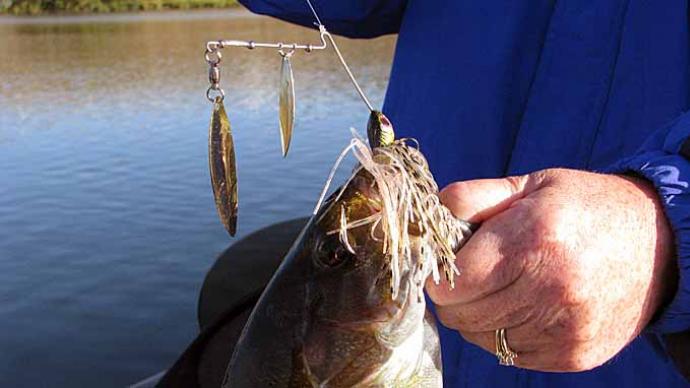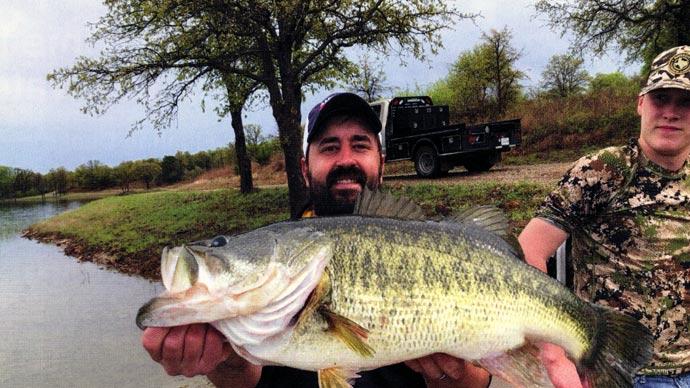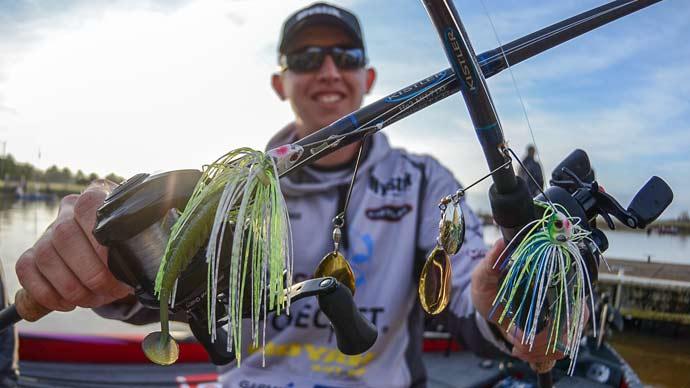
When choosing a spinnerbait rod and reel, You should look for a high-quality graphite rod and a reel with a high speed 6:3:1 gear ratio. Select a 7-foot medium-heavy rod with a long cork handle or a trigger rod. The long cork handle will give you more solid hooksets than if you were fishing with a casting rod. I recommend a Daiwa Tatula CT casting reel and a Daiwa Tatula casting rod. The 7-foot length and medium-heavy action will give you the power to make the hookset, feel the spinnerbait's vibration, and land the biggest bass.
When selecting a quality line, go with Seaguar InvizX. You can use a heavy line because it is mainly a reaction strike.
The bass don't have enough time to examine the spinnerbait or the line. I like to use Seaguar InvizX in 15-pound because it will get the fish out of cover and resists nicks and cuts when you bump the bait against cover.
Using green or clear lines doesn't seem to matter in most water clarities. Using a clear line is more reasonable because the bass usually look up to the spinnerbait, with the surface and the sky as a background, although this is not true when you are working the spinnerbait on the bottom.
Companies like Strike King have a good selection when it comes to spinnerbaits. They have small spinnerbaits like the Rocket Shad, all the way to the larger Premier Pro-Model Spinnerbait. This lure comes with double Colorado blades. This is an excellent bait for stop-and-go retrieves around laydowns. The little Rocket Shad is great for when the bass get "lockjaw" in the fall.
Clear, sunny days are NOT the best days for spinnerbaiting. Of course, you could go for a reaction strike by bumping the spinnerbait up against the cover, but you want a cloudy day with a little chop on the water. Try throwing into the wind and retrieving with the current. Select a heavier spinnerbait for this situation. The bass will position themselves on or under the cover on sunny days.
For this kind of day, select a neutral color for the skirt. Chartreuse can sometimes be too bright, but not always. White, alpha shiner, or a translucent skirt will work well on sunny days. These are the best conditions for silver or nickel blades. You must slow down your retrieve on these "bluebird" days because the bass will be less active.
Cloudy days call for Gold and holographic blades. Chartreuse/white, firetiger, and pink skirts work well. Bass will almost cruise around cover rather than getting under it on cloudy days. Bass may cruise up to six feet around the cover. Some will stay in ambush points, which may be in the cover.
Spinnerbaits are great for throwing around or under docks, around rockpiles, banks lined with rip-rap, laydowns, weedlines, and even ledges. To fish ledges, a heavy 1-ounce spinnerbait is almost a must. You must keep the bait in the strike zone as long as possible.
Remember that in the depths, your bait will lose its' color. There are a few colors that keep their color in the deeper waters. These include purple, chrome, and a few darker colors.
Remember to match the forage your bass are feeding on, or "Match the Hatch," as a fly fisherman says. The alpha shiner pattern should produce fish if the bass feed on gizzard or threadfin shad. If the bass are feeding on crawfish, like in the spring, and you want to cover a lot of water quickly, a red, black, or brown spinnerbait should put out results. You should also try to match the spinnerbait size with the forage. Most Gizzard shad are under 4 inches, so a 3/8-ounce spinnerbait should be good. A small Strike King Rocket shad should do well if your fish feed on threadfin shad.
You need to have a good amount of confidence in your colors. Sometimes, your gut instinct will tell you the best color. You may ask, "How do I find out what the bass are feeding on?" Well, first, you should check out the banks to check for crawfish holes. Then, see if you have schools of shad or baitfish on your depthfinder. Sometimes, you can even visually spot the schools.
Once, I was fishing down at Barkley Lake. Many boats were out that weekend, and the waves pushed schools of baitfish into a small cove. You could see the bass chasing the shad out of the water because the shad would jump all around the cove. Because when one changes direction, the others follow. They sort of work as a team by keeping lookout for one another.
If you're fishing around a boat dock, many different kinds of forage exist. You could have shad, bluegill, and crawfish from the rip-rap bank. When fishing an underwater hump, shad will be the primary forage. If you're fishing in a rocky area, crawfish will most likely be present. Chartreuse, or firetiger, is an excellent color to represent bluegill. Brown, black, or purple can imitate a crawfish. Alpha shiner, white, and white and chartreuse can be for shad.
When fishing clear water, a willow leaf blade will produce more flash than vibration, so this will be your best bet. Chartreuse blades have been known to catch a good amount of smallmouths on northern waters. An Indiana or Oklahoma blade is a good choice when fishing stained water. It will produce an even amount of flash and vibration. In muddy waters, a single, large Colorado blade works well. A single blade produces more vibration because it resists water flow over the blade, creating more vibration. Use black or gold blades in muddy water.
Large Colorado blades are best for slow-rolling a spinnerbait. The large blades produce more lift than other blade styles.
I always tie a uni-knot on all of my spinnerbaits. Make sure you wet your line before you tie this knot. If you fail to wet the line, it will weaken your line when you pull the knot tight.
Most pros agree that sharpening your hooks is very important—most like to use a 3-point technique. You can get a file and sharpen it at three points at the hook. It would be like a triangle. This triangle point will be powerful. You only need to make about three strokes per side on the hook.
Have you ever thought of adding a trailer to your spinnerbait? There are different kinds of trailers for spinnerbaits. You can have a trailer hook or a trailer. The trailer hook will help you land more bass when they short-strike it. Some like to add a piece of pork or plastic to their spinnerbaits. I like to put a Zoom Split Tail Trailer on the back of my spinnerbait. Trailers should be used in muddy water to increase the size of your bait. This will allow the bass to find it easier.
With these tips, you can land a few more bass with spinnerbaits. Apply these tips on the lake, and you should be in for a great day of Bassin' out on your favorite lake. See you at the scales!




